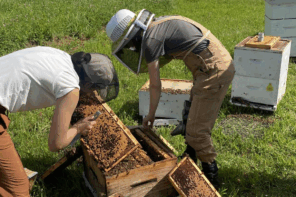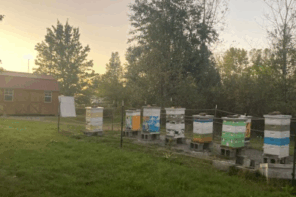By: Ann Harman
This article originally appeared in the Summer 2020 issue of BEEKeeping Your First Three Years
Each year in January we get a new calendar to hang up. Although today we may use our cell phones to keep track of events a decorative calendar still is handy to remind us of things to do and places to go. Our calendars run from January through December because that is our (human) year. It does not matter where you live, whether in a cold or in a hot climate. However the honey bee has a different calendar.
The bee calendar year is different from that of humans. Although their events are basically the same for them over a period of time, the timing of when their events occur depends on where you live.
You can certainly put notes about your bees and their needs on a regular calendar or on your cell phone or computer but making a calendar designed for bees in your climate will certainly make you think about their life through the months. The calendar you make will start at your bees’ New Year, a bit different from human’s. And definitely appropriate for your climate.
You have some choices in making your bee calendar. If you make your own, each month can start on the same day. But if you choose a Sunday you will have endless Friday the 13ths. That’s OK, the bees don’t mind. You can use a decorative calendar you received from last year or even several years ago. Exact dates generally do not work very well with bee calendars. Weather can influence certain events. However you can use dates as a guide for you.
You bee calendar can be a perpetual one. This would be one where you will just note certain things that occur in the bee’s year and have to be done or checked inside the hive throughout the seasons. Or you can just make a new one each year and keep records on it, such as rainfall. Rainfall is important in many ways: your bees need a source of water during their active seasons; too much or too little rain affects the nectar and pollen plants; endless days of rain affects bee flight time for collecting nectar and pollen. How good are you at remembering what the weather was like last Thursday? If you have not put rain in your bee records, now is a good time to do that. So is the opposite-lack of rain, drought. Weather is inconsistent from year to year.
If you have been attending your local beekeeping club meetings you have become aware of your bee’s year. You have heard about swarm time, enough food for the Winter months, time to put honey supers on and take them off for harvest, as well as testing for Varroa and any other health conditions. If a local beekeeping club is not convenient, beginning beekeepers who have mentors can make use of their information. If all you have are some excellent books you will have to adjust the information to your climate. The bees’ year in Maine has different dates and times from that in Arizona.
As soon as you have 12 calendar pages you can start to create your bee calendar. New Year for bees begins at the time our Summer is coming to a close. The hours of daylight are becoming less. Plants are responding to the changes in length of daylight and also to any temperature changes. Bee New Year begins around the time when the queen starts to produce Winter bees and then prepares to take a break from egg laying. Although there really is no exact day you can choose one for your bees.
That day will remind you to check for adequate food stores that must last the duration of your Winter months. You still have some time to provide syrup for Winter stores if the bees need it. If you plan to do a Varroa check enter that note on your bee calendar.
Have you been keeping records throughout your beekeeping time? Although this is not the ending of your bee season, now is a good time to review those records. Do you see anything you need to change for the coming year? Is there something you forgot to do because you simply forgot? You can put a reminder on your bee calendar right now.
After the population of Winter bees has been established, it is now time for the queen to take a rest from egg laying. Again, climate dependent, her rest maybe very short or extend over several months. Note on the bee calendar the approximate day she begins and ends her “Winter vacation.” A broodless time may be when you wish to do a Varroa treatment. Having the information on the bee’s calendar is a good reminder.
As the colony is progressing towards Spring the bees are approaching their swarm time. Have you noticed when you have first seen drones at the entrance preparing to take flight or have noticed them inside the colony? You can now make a note on the bee’s calendar that it is “drone time.”
This time is followed by “swarm time.” That is an important item to put on your calendar. Not every colony will swarm but those with older queens may do so. You may wish to let them swarm for a break in the brood cycle to help control Varroa. You may be hoping to catch the swarm to increase your number of colonies. Or you may wish to prevent a swarm, especially if your honey-crop plants bloom in early Spring. A swarm decreases the number of worker bees. No matter what you wish to do, put “beginning of swarm season” on your bee calendar. That reminder will help you plan your bee year.
Do you know the honey-crop plants in your area? You should know what those plants are and the approximate bloom date. Some parts of the country have more than one honey-crop time. If so, don’t forget to note both of those periods on the bee calendar. Do you have your honey supers ready? If you have noted on the bee calendar when bloom starts you should be able to harvest honey (if your weather cooperates). Keep watch on those plants and your bees.
At some point all those honey-crop plants will finish blooming. Here is another date to record-end of bloom. Now you know it is time to let the bees finish ripening the honey and capping it. The next event is removing the honey supers and harvesting your honey. You can note the day you begin that project. That information will help you next year.
Your separate beekeeping records should have your plan for Varroa tests and controls. If you live in small hive beetle area those comments would also go into your own general records. Neither Varroa nor beetles are part of the bee calendar. This calendar is for events in the lives of bees and their interactions with their world. Your records for results of Varroa tests and treatments are very important but they are not controlled by the bees. Think of what the bees plan to do with their lives.
After honey harvest time do you know what your bees are planning to do? Perhaps the bees have no particular project until preparation for Winter. It could be a time for supersedure. This is frequently a rather quiet beeinitiated project. Queen cups are made and tom down throughout bee season so it is easy to overlook any progress being made with one of them. So perhaps you can make a note on their calendar as well as in your records. Since the colony may not do that every year you can put a question mark on both their calendar and in your records. It would be a reminder to check those queen cups. One problem with supersedure late in the Summer is the lack of drones. The queen may get mated but not with a sufficient number of drones for a good mating. Your own records need to have that information for clues to future problems.
Drones are an event in the bee calendar. You can note “drones out!” if you wish. You watched them appear in the Spring. Now you may notice drones being dragged or shoved out of the hive. You may see them being harassed at the entrance. The bees know that they are old and that there is no need for mating flights. However, do not be worried if, in the middle of Winter, you see a drone or two inside the hive. He is just living happily, feeding himself, but will be dying of old age some time during the Winter. The bees will tolerate the presence of a few drones throughout the Winter months. They are not depleting the honey stores.
As your Summertime is winding down you do need to pay attention to the world around your bees. Their needs are simple-water and food. Not only for daily survival but for the Winter days to come. You need to make sure the bees are storing enough pollen and honey for their Winter months ahead. In all but a few areas of the country the food supply will cease and bees will be in a cluster.
You need to note on the bee calendar when the queen seems to be stopping, or has stopped, laying eggs. The queen is “on vacation” until the days begin to lengthen. Just consider it her “time on a cruise to the tropics.” She will be kept warm, well-fed and groomed.
You have completed the bee calendar. It really is a simple calendar compared to ours. But if we recognize the events that occur in a bee year we can do a better job of beekeeping. The important thing to remember is that a bee calendar is made appropriate for the climate, even the microclimate, the bees are living in. In years with strange weather events, such as a warm Winter in a cold climate, the bee calendar will need to be modified. However the sequence of events will remain the same.
I am sure the bees will appreciate their own special calendar. After all, it is making you a better beekeeper.









